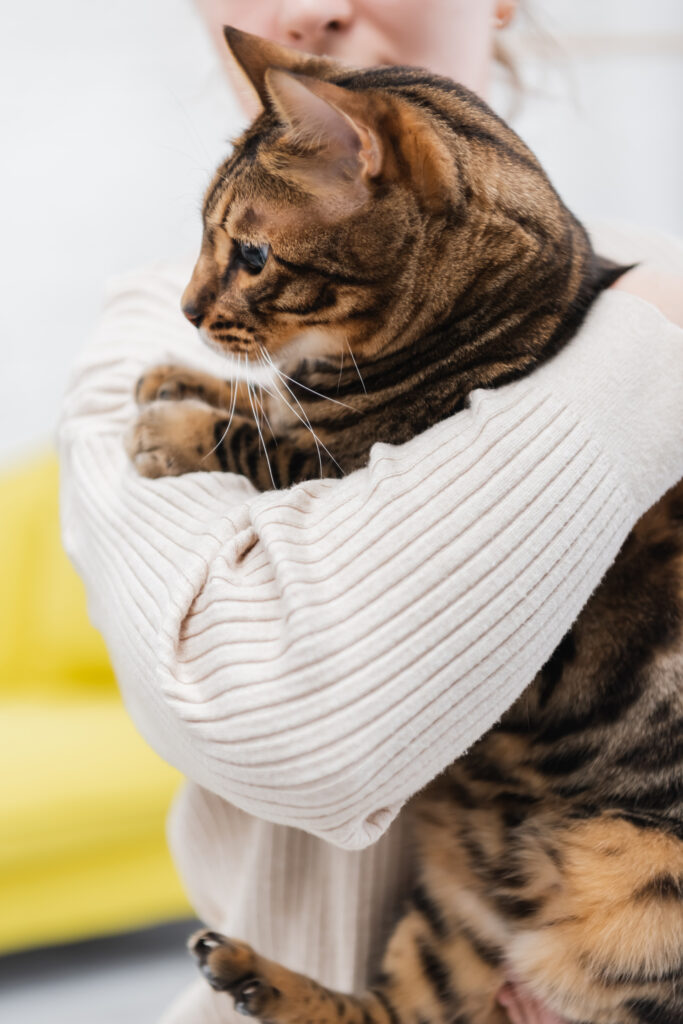If you’re wondering how to discipline a Bengal cat, you’re not alone! Using physical punishment isn’t the best way to deal with unwanted behavior, and it will destroy your bond with your Bengal. However, certain methods can discourage unwanted behavior. Ignoring your cat’s actions is an excellent way to let him know that such behavior will not be tolerated. Using sounds to discipline your Bengal cat can also be an effective solution.
How do I get my Bengal cat to stop misbehaving?
The best way to discipline your Bengal cat is to redirect his behavior when you see him doing something he doesn’t want to do. Never call him by name to make him stop – say “STOP” or “NO” instead. You don’t want to confuse him with your Bengal’s name by calling him by the wrong word! Instead, reward your Bengal with a treat when he does something right.
Despite their high activity level, Bengal cats are naturally highly hyperactive. They may attempt to get on countertops or sinks for a variety of reasons, including the sound of running water. They may even try to scratch up the furniture. Even when they aren’t doing anything wrong, these behaviors can escalate if left untreated. Here are some tips to teach your Bengal how to stop misbehaving and make your life easier.
First, set a routine. whether your Bengal cat begins misbehaving, establish a routine and stick to it. If your Bengal cat acts out of character, say “STOP” in a firm voice. If he continues to engage in bad behavior, praise him with treats and verbal praise. Your Bengal cat will soon learn that this behavior is not acceptable. If you’d rather not punish your Bengal cat, consider introducing him to a different type of pet or fostering him in a new home.
While training a Bengal cat can be a challenging task, be persistent and consistent. Remember that your cat is a sensitive creature, and may react differently to punishment. As with any animal, it takes time and patience to train your cat. If you punish him harshly, your Bengal may get upset and become afraid of the process. You can also introduce some new rewards to your Bengal so that he will learn how to accept positive reinforcement and stop misbehaving.
Spanking is one method that may be tempting, but it’s not good for your cat’s health. While it may stop a particular behavior, it may hurt the relationship between you and your pet. Physical punishment is also unkind to your Bengal’s sensitive skin. This method may not be effective for your cat, but it’s the best option if you’re concerned about your Bengal’s behavior.
How do I properly punish my cat?
A Bengal cat responds well to correct discipline. However, some types of Bengal cat behavior can be difficult to control, especially when it comes to aggression. Bengals are people-oriented and love attention, so they may try to annoy you by misbehaving. Keeping in mind that Bengals are habitual creatures, correcting unwanted behaviors can be difficult, but it is possible to redirect them into acceptable behavior.
One of the first steps in addressing your cat’s behavior is to create deterrents. Bengal cats are attracted to the smell of food, and they will often try to nibble on food while the owner isn’t looking. This is both unsanitary and dangerous for your cat. If you want to prevent your Bengal from scratching your couch cushions, place an uncomfortable mat on the floor. Also, enclose your favorite items as off-limits by putting child locks on cabinets and storage bins.
Another way to discipline your Bengal cat is to make it understand your rules and expectations. Screaming at a Bengal cat is not an effective method of punishing bad behavior. It might even make matters worse because the cat may not understand what you are trying to do. In any case, it can be counterproductive. Instead of shouting at your Bengal cat, try to reward your cat for good behavior.
A good way to correct bad behavior is by letting the cat know what they can expect from you. Usually, punishing a cat for something like scratching a rug is counterproductive. This makes them more fearful of the owner. And, as a result, they may become aggressive with you. If you’re not there to correct the behavior, a cat will simply become fearful of you and will be even more aggressive.
When disciplining your Bengal cat, don’t use physical punishment. Cats can’t understand physical punishment, and when they are hit, they will interpret it as aggression. When you hit your Bengal cat, you will likely lose their trust and confidence. You may even end up with a grumpy cat that has a history of attacking people. Instead, try rewarding good behavior by using positive reinforcement like treats or playtime.
How do you stop Bengal cats from attacking?
The first step in stopping Bengal cats from attacking is to understand their behavior. If your Bengal cats have been aggressive or play aggressive, it is likely that they are not properly socialized and do not respond well to punishment. If this behavior is caused by hormones, you should see a vet for an evaluation to determine if there is a hormonal imbalance or an underlying health issue. However, in some cases, the aggressive behavior is due to frustration with the Bengal cat owner and can be resolved through more playtime.
A Bengal cat’s behavior can be triggered by many things. It may seem calm one minute and suddenly become aggressive or frightened. This is a normal phase of kittenhood when they are getting used to the world and their new senses. When your Bengal cat experiences stress or a new smell, it may overreact to the new environment. Therefore, you should try to avoid situations where your Bengal cat feels threatened or anxious.
As a kitten, your Bengal cat might view your hand as a toy. You can use hot sauce or other non-toxic sprays to discourage your cat from biting. If nothing works, use a cat wheel or playtime with a Bengal cat. This will help to tire them out. Eventually, the biting behavior will stop. It may even go away completely. You can’t prevent your Bengal from attacking others, but you can discourage it with a few simple tricks.
Remember that Bengals are territorial and will not attack you unless you provoke it. They’ll react to your hissing as a friendly gesture. Bengal cats will likely be friendly to you even if you don’t believe in it. If you don’t want to provoke them, you can try to keep them inside. You can also try using a gentle technique to make them realize that their territory is yours.
One of the most effective tricks is to ignore their aggression. When your Bengal cat is aggressive, it’ll respond by attacking you. Try to avoid touching your cat or grabbing its neck. This will only escalate their aggression and cause you to lose control. Besides, the cat may perceive your aggressive behavior as your dominance. You should always remember that these techniques don’t work for everyone. You can make your Bengal cat behave better by training it to stop attacking.
how to Use sounds to discipline your Bengal cat
If you’re looking to discipline your Bengal cat, you need to know a few things about this breed. Bengals are extremely intelligent and can learn from verbal cues, including sounds. This can make training them a difficult task, but using sounds can help. But be sure to use them in the most humane way possible. You should never punish your Bengal cat for doing something that’s against its nature, as this could be considered cruel and illegal.
Using sounds can also be a great way to teach your Bengal cat that “NO” is the same as “Stop” in your voice. Bengals will learn that “NO” means stop, so if you say it in a soft voice, it will not move. Instead, try using different tones of your voice for the word “NO.”
Treats can help you train your Bengal cat to respond to your commands, such as “Sit.” Using treats as rewards is a great way to encourage your Bengal to follow your commands and avoid potential danger. Make sure you offer treats before giving him food since Bengals respond to rewards most effectively. And don’t forget to praise him often! But don’t ignore your Bengal. I will appreciate all your efforts!
Another effective way to discipline your Bengal cat is to use stop words. This tactic will deter your cat from doing something inappropriate by stating a specific word. When teaching your cat this new method, make sure to use it in a clear and consistent voice. It will take practice, but it will eventually work! And you’ll be amazed at how fast you’ll see results in just a few weeks!
Your Bengal cat’s nose is incredibly sensitive. It’s easy to mistake a “no” for a positive response. This method also works well if you’re trying to discourage your Bengal from chewing on your furniture. It may even start chasing food or stealing your treats. But you must know that Bengal cats are extremely demanding and act out if they’re not getting the attention they need. So, if you notice a certain behavior, don’t react immediately. Your Bengal will soon learn not to repeat it.





